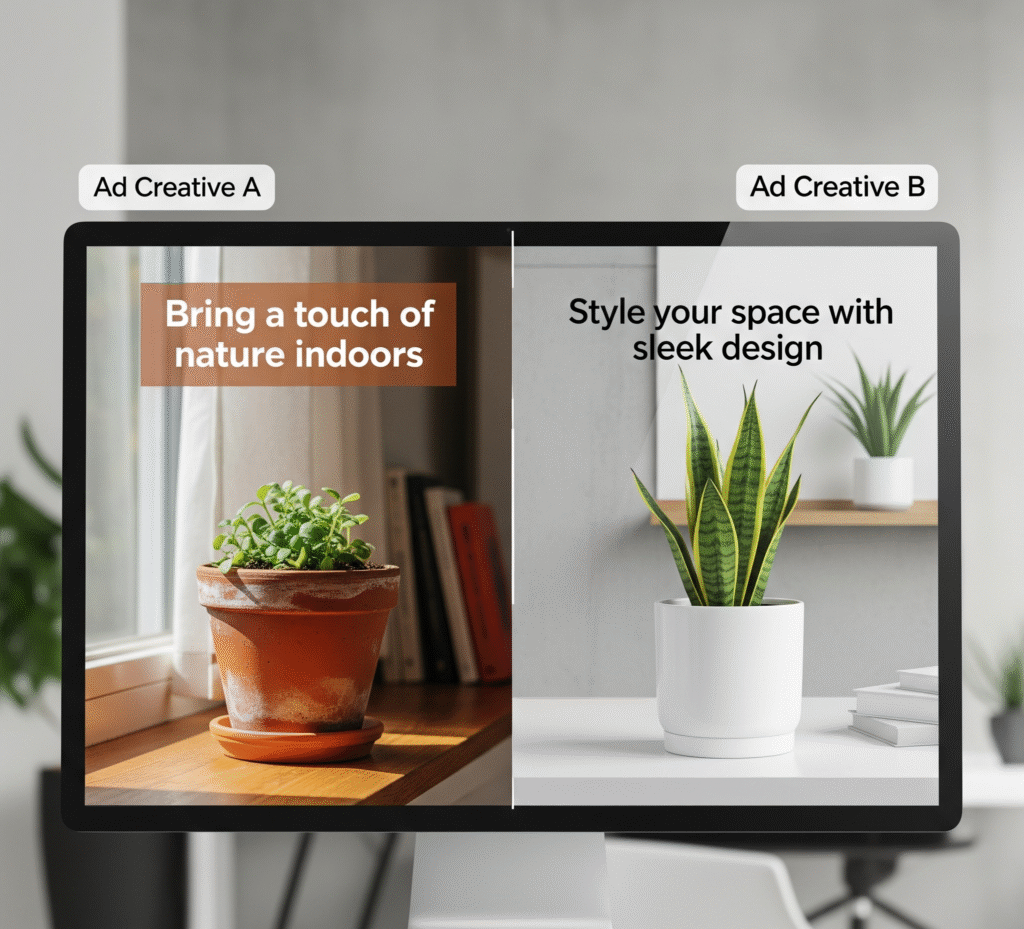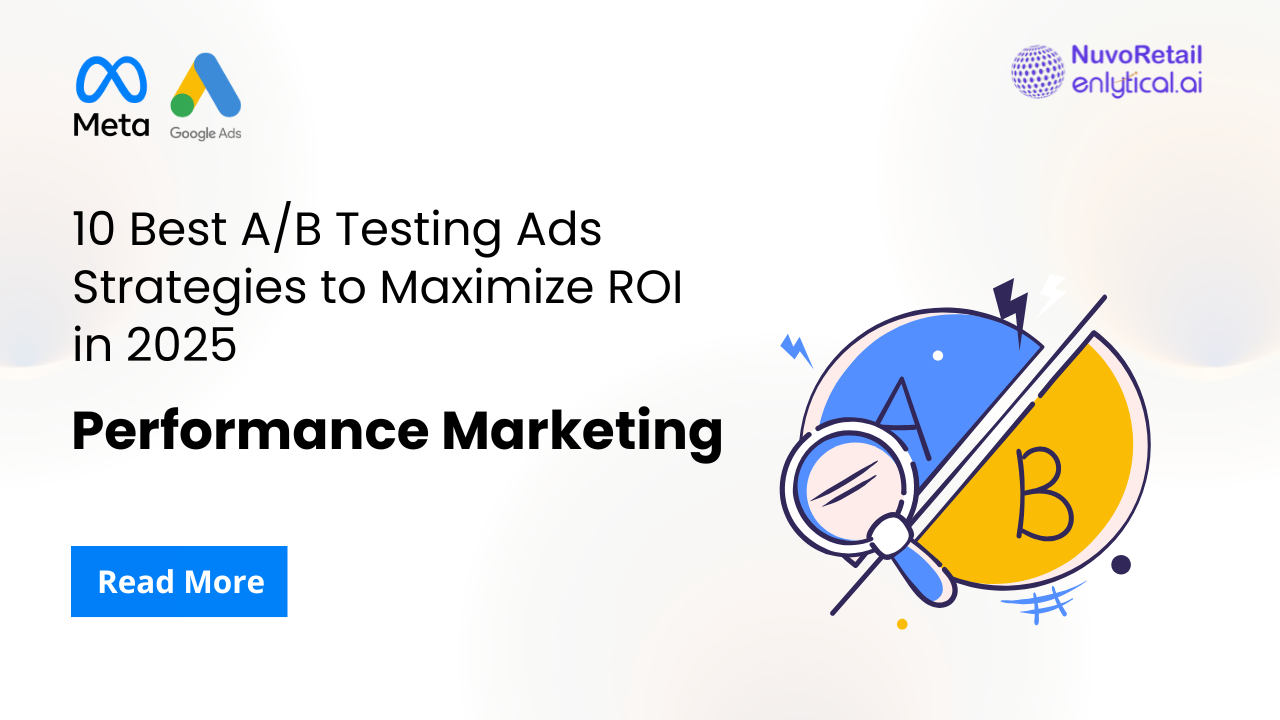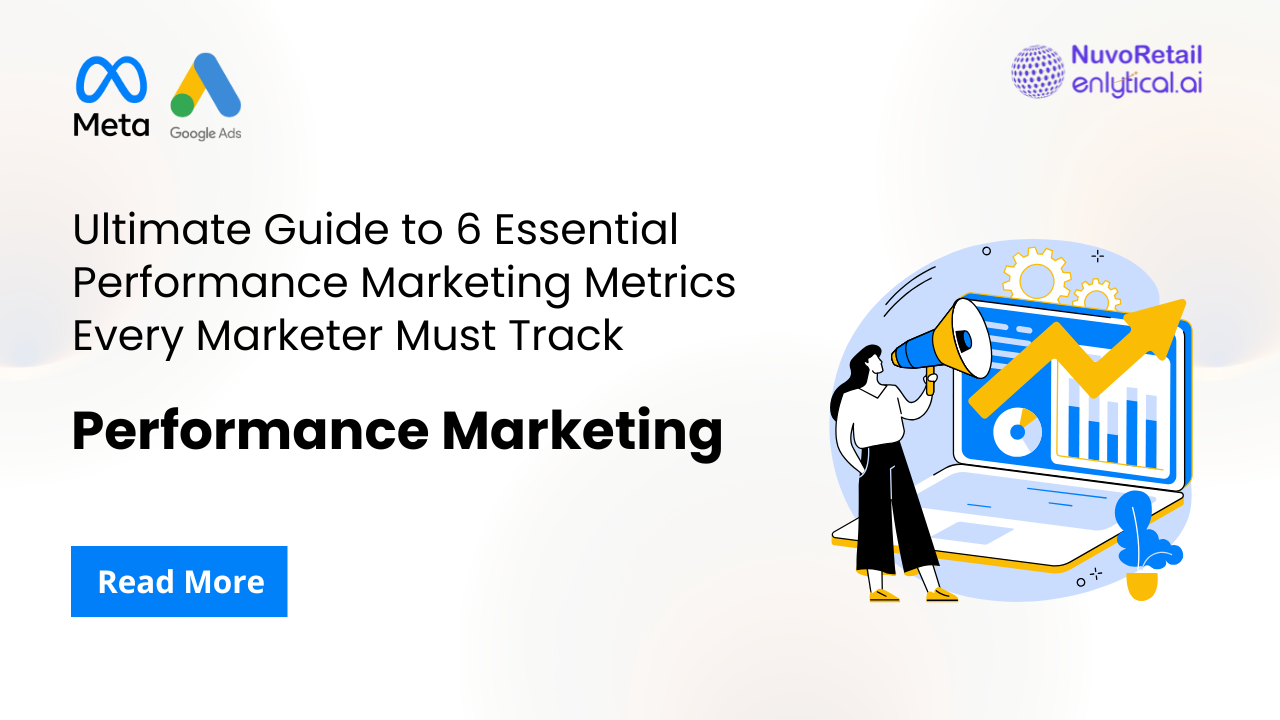A/B testing ads is the cornerstone of successful digital marketing campaigns that can dramatically transform your return on investment. Whether you’re managing Google ads campaigns or navigating the Meta ads manager, A/B testing ads systematically separates profitable campaigns from budget drains.
In today’s competitive digital landscape, businesses that master A/B testing ads consistently outperform those that rely on guesswork, achieving 20-30% higher conversion rates and significantly improved ROAS.
At NuvoRetail, we help brands unlock these kinds of results by combining A/B testing ads expertise with data-driven performance marketing services tailored to both Google Ads and Meta platforms.
Table of Contents
- Understanding A/B Testing Fundamentals for Digital Advertising
- Setting Up Your Testing Framework in Google Ads
- Mastering Meta Ad Manager Testing Tools
- 10 Best Elements to Test for Maximum Impact
- Measuring Success: Key Marketing Metrics That Matter
- Advanced Testing Strategies for Performance Marketing
- Common A/B Testing Mistakes That Kill ROI
- Conclusion
Understanding A/B Testing Fundamentals for Digital Advertising
A/B testing ads involves creating multiple variations of your advertisements and systematically comparing their performance to identify the highest-converting version. This data-driven approach makes A/B testing ads essential for eliminating guesswork from your digital marketing strategy.
The foundation of effective A/B testing lies in understanding your baseline metrics. Before launching any test, document your current click through rate, conversion rate, and ROAS. These benchmarks will help you measure the true impact of your optimizations.
Most digital marketing agencies recommend testing one variable at a time to isolate the impact of each change. HubSpot also emphasizes that running A/B testing ads by changing only one element per test and letting the test run until results are statistically meaningful is critical to avoid misleading outcomes. This methodical approach ensures you can attribute performance improvements to specific elements rather than multiple simultaneous changes.

Setting Up Your Testing Framework in Google Ads
Google advertising platforms offer robust A/B testing ads capabilities through their native tools. When you advertise on Google, the ad manager provides built-in testing features that streamline the process.
Start by accessing Google Ads’ Experiments feature, which allows you to split your traffic between original and test campaigns. This ensures statistical significance while maintaining campaign performance during testing periods.
Key setup steps include:
- Defining your test hypothesis clearly is the foundation of effective A/B testing ads.
- Setting appropriate traffic allocation (typically 50/50)
- Determining test duration based on your traffic volume
- Establishing success metrics aligned with your marketing performance goals
According to WordStream’s case studies, even small variations tested through Google Ads experiments such as headline or description changes can lead to improved Quality Score and lower cost-per-click when implemented properly.
NuvoRetail’s team specializes in setting up Google Ads experiments, ensuring brands not only improve Quality Score but also scale campaigns efficiently without wasting ad spend.
Mastering Meta Ad Manager Testing Tools
The Meta ads manager provides sophisticated A/B testing ads capabilities through their built-in testing framework. Whether you’re running single meta ad campaigns or complex funnel sequences, the platform’s testing tools can significantly improve your marketing metrics.
A/B testing ads in Meta differs from Google ads in its emphasis on creative variations and audience segmentation. The Meta ads manager excels at testing visual elements, ad copy variations, and audience targeting simultaneously.
When working with any advertising agency or digital marketing services provider, ensure they’re utilizing Meta’s advanced testing features including dynamic creative optimization and automated audience expansion based on test results. These features make A/B testing ads in Meta both scalable and precise.
Our Meta ad specialists at NuvoRetail leverage these exact tools to optimize creative performance and maximize ROI across Facebook and Instagram placements.
10 Best Elements to Test for Maximum Impact
1. Headlines and Ad Copy Variations
Your headlines directly impact CTR and initial engagement, making them one of the most critical elements in A/B testing ads. Test emotional triggers like “Transform Your Business Today” versus benefit-focused copy such as “Increase Sales by 40% in 30 Days” to identify what resonates with your audience.
Question-based headlines often perform exceptionally well because they create curiosity and engagement. Compare variations like “Are You Making These Marketing Mistakes?” against direct statements like “Stop Making These 5 Marketing Mistakes.” Additionally, test urgency-driven copy (“Limited Time Offer”) versus value-proposition focused messaging (“Get More Leads for Less”).
Make sure to test headline length variations as well. Short, punchy headlines (under 30 characters) often work better for mobile users, while longer, descriptive headlines may perform better on desktop platforms.
2. Visual Creative Elements
Images and videos are crucial for Meta ads success and play a central role in A/B testing ads across Google campaigns as well. Test different product angles, lifestyle imagery, and video lengths to optimize visual performance across all your advertising efforts.
For product-based businesses, compare clean product shots against lifestyle images showing your product in use. Test user-generated content versus professionally produced imagery, as authentic customer photos often outperform polished studio shots. Video content should be tested for optimal length – typically 15-30 seconds for social media platforms, though this varies significantly by audience and industry.
Unbounce showcases several real-life examples where testing visual variations like image vs. video resulted in double-digit conversion lifts, proving the impact of creative testing on marketing performance and overall ROAS.
Color psychology plays a significant role in visual performance. Test warm colors (reds, oranges) against cool colors (blues, greens) to see which generates better engagement with your specific audience. Many performance marketing teams also test the presence or absence of text overlays on images, as platforms like Meta have specific guidelines that can impact ad delivery.
3. Call-to-Action Buttons
Different CTA buttons can dramatically impact conversion rates, making them essential elements in your A/B testing ads strategy. Test variations like “Learn More,” “Shop Now,” “Get Started,” “Claim Your Free Trial,” and “Download Now” to find your optimal choice.
The psychology behind CTA language matters significantly. Action-oriented CTAs like “Get Instant Access” often outperform passive language like “Click Here.” Test first-person CTAs (“Start My Free Trial”) against second-person versions (“Start Your Free Trial”) to identify which creates stronger personal connection with your audience.
Consider testing CTA button colors as well – contrasting colors that stand out from your ad creative typically perform better. Many digital marketing services teams recommend testing at least 3-4 CTA variations per campaign to find the highest-converting option for each specific audience segment.
4. Audience Targeting Parameters
Both Google ads campaign targeting and Meta audience selection benefit from A/B testing ads strategies. Compare broad versus specific targeting to optimize reach and relevance while maximizing your return on investment.
For Google advertising, test different keyword match types (broad, phrase, exact) to find the optimal balance between reach and relevance. In Meta ads manager, experiment with interest-based targeting versus lookalike audiences based on your existing customers. Test demographic variations like age ranges, geographic locations, and device preferences to identify your highest-value audience segments.
Behavioral targeting offers another powerful testing opportunity. Compare audiences based on recent purchase behavior versus those showing research intent. Many advertising agencies also recommend testing custom audiences built from your email lists against cold prospecting audiences to optimize budget allocation across the customer funnel.
5. Bidding Strategies and Budget Allocation
A/B testing ads with different bidding approaches helps improve ROI and overall marketing metrics. Compare manual bidding against automated strategies to find your optimal approach for each campaign objective.
In Google ads, test Target CPA bidding against Manual CPC to see which delivers better cost efficiency for your specific goals. For Meta ad campaigns, compare automatic bidding against bid caps to maintain cost control while maximizing delivery. Many marketing agencies find that hybrid approaches work best – starting with automated bidding to gather data, then switching to manual control for optimization.
Budget allocation testing is equally important. Test different daily budget amounts to find the sweet spot where increased spend translates to proportional performance improvements. Some campaigns benefit from aggressive budget increases, while others hit performance plateaus that waste advertising spend.
In a case study, Marin Software showed that intelligent budget pacing helped a client increase revenue by 20% in one month through real-time adjustments.
6. Landing Page Alignment
Ensure your ad creative aligns with landing page messaging; this alignment is critical when running A/B testing ads to maximize conversion rates and campaign performance. Test different page variations to identify the optimal user experience that maximizes your advertising investment.
Message matching between ads and landing pages is crucial when A/B testing ads for maintaining user trust and conversion momentum. If your ad promises “50% Off Everything,” your landing page should immediately reinforce this offer above the fold. Test different headline variations, hero images, and page layouts to optimize the transition from ad click to conversion.
Page load speed significantly impacts conversion rates, especially for mobile traffic. Test different page versions with varying complexity levels – sometimes simpler pages with fewer elements outperform feature-rich alternatives. Many digital marketing companies recommend testing dedicated landing pages against sending traffic to existing website pages to measure the impact of specialized conversion optimization.
7. Ad Scheduling and Timing
Test different days and times to identify when your audience is most responsive. Phonexa’s case study shows dynamic bidding based on time-of-day can reduce costs and lift conversions especially during peak hours. This optimization can significantly improve your overall marketing performance while reducing wasted spend during low-performing periods.
Dayparting analysis is a powerful application of A/B testing ads that helps identify peak performance windows for your specific audience. B2B campaigns often perform better during business hours, while B2C campaigns may see higher engagement during evenings and weekends. Test different time blocks systematically rather than relying on industry generalizations.
Seasonal variations also impact ad performance significantly. Test different messaging and offers during various times of year, holidays, and industry-specific peak periods. Many performance marketing teams create testing calendars that account for seasonal trends, competitor activities, and market conditions that influence audience behavior.
8. Ad Placement and Format Testing
Test different ad placements across platforms and various ad formats (carousel, single image, video) to identify the most effective combinations for your campaigns and maximize your click through rate.
Within Google ads, test search network versus display network performance for your specific offers. Video ads on YouTube may perform differently than the same creative on the display network. For Meta advertising, test feed placement against story placement, and evaluate performance in Instagram versus Facebook environments.
Ad format testing reveals significant performance differences. Carousel ads allow showcasing multiple products but may have different engagement patterns than single image ads. Video ads typically achieve higher engagement but may have higher production costs. Test static images against dynamic creative optimization to see if personalized ad elements improve performance for your specific audience segments.
9. Price and Offer Testing
Experiment with different pricing strategies, discount amounts, and promotional offers through A/B testing ads to find the sweet spot that maximizes both conversions and profit margins while improving your overall ROAS.
Price anchoring techniques can be tested through different offer presentations. Compare “Save $50” against “25% Off” to see which creates stronger purchase motivation for your audience. Test limited-time offers against evergreen pricing to evaluate the impact of urgency on conversion rates.
Bundle offers versus individual product pricing often show significant performance differences. Test different package configurations and pricing structures to identify optimal value propositions. Many business consulting experts recommend testing price points systematically rather than making dramatic pricing changes that could negatively impact brand perception.
10. Device and Platform Optimization
Test performance across mobile, desktop, and tablet devices to optimize your A/B testing ads for the platforms where your audience is most engaged and likely to convert, ensuring maximum marketing performance across all touchpoints. Enhencer’s recent analysis found mobile ads drive 60-70% of clicks in many markets, and that creative and placement changes optimized for mobile tend to outperform desktop variations.
Device-specific creative optimization often reveals significant opportunities. Mobile users may respond better to vertical video formats and shorter ad copy, while desktop users might engage more with longer-form content and detailed product information. Test different creative dimensions and messaging approaches for each device type.
Cross-platform performance varies significantly by industry and audience demographics. Your Meta ads may perform exceptionally well on Instagram but show poor results on Facebook, or vice versa. Test platform-specific messaging and creative approaches rather than using identical content across all channels. This granular approach to testing helps digital marketing advertising agencies maximize performance for each unique platform environment.
Measuring Success: Key Marketing Metrics That Matter
Effective performance marketing requires tracking the right metrics throughout your A/B testing ads process. While vanity metrics like impressions might look impressive, focus on metrics that directly impact your bottom line.
Primary metrics to monitor include:
Click Through Rate (CTR): Indicates ad relevance and appeal to your target audience. Higher CTR typically leads to improved ad quality scores and lower costs.
Return on Ad Spend (ROAS): The ultimate measure of campaign profitability. Calculate by dividing revenue generated by ad spend.
Conversion Rate: Measures how effectively your ads drive desired actions, whether purchases, signups, or other goals.
Cost Per Acquisition (CPA): Tracks how much you’re spending to acquire each customer or lead.
Leading marketing agencies emphasize the importance of statistical significance in A/B testing ads. Ensure your tests run long enough to gather meaningful data, typically requiring at least 100 conversions per variation for reliable results.
For comprehensive campaign analysis, consider partnering with NuvoRetail, a specialized digital marketing advertising agency, that can provide advanced analytics and optimization services.
Advanced Testing Strategies for Performance Marketing
Once you’ve mastered basic A/B testing ads principles, implement advanced strategies to maximize your competitive advantage.
Sequential Testing: Run tests in phases, using insights from initial tests to inform subsequent variations. This approach builds upon learnings rather than starting fresh each time.
Multivariate Testing: For high-traffic campaigns, test multiple elements simultaneously. This approach requires larger sample sizes but can identify powerful combination effects.
Holdout Testing: Maintain a small percentage of untested traffic as a control group to measure the cumulative impact of your optimization efforts.
Cross-Platform Testing: Coordinate tests between Google ads and Meta ads to identify platform-specific preferences while maintaining consistent brand messaging.
Professional business consulting services often recommend implementing testing calendars to ensure consistent optimization efforts without overwhelming your team or audience with too many simultaneous changes.
Common A/B Testing Mistakes That Kill ROI
Even experienced digital marketing services teams make critical errors that undermine testing effectiveness. Avoid these common pitfalls:
Testing Too Many Variables Simultaneously: When you’re A/B testing ads, testing too many variables simultaneously makes it impossible to identify which changes drove performance improvements.
Stopping Tests Too Early: Insufficient data leads to false conclusions and poor optimization decisions.
Ignoring Statistical Significance: Making decisions based on small sample sizes or short testing periods.
Not Documenting Test Results: Failing to maintain detailed records prevents learning from past experiments.
Testing Without Clear Hypotheses: Random testing wastes resources and provides little actionable insight.
Follow rigorous testing protocols and provide detailed reporting on all experiments. Successful A/B testing requires patience, systematic thinking, and commitment to data-driven decision making.
Conclusion
A/B testing ads represents the most reliable path to improving your digital marketing ROI across both Google and Meta platforms. By systematically testing creative elements, targeting parameters, and campaign structures, you can achieve significant improvements in CTR, ROAS, and overall marketing performance.
The key to successful A/B testing lies in maintaining disciplined testing protocols, measuring the right metrics, and applying insights consistently across your campaigns. Whether you’re managing campaigns internally or working with a digital marketing agency, these 10 best strategies provide a roadmap for optimization success.
Remember that A/B testing is an ongoing process, not a one-time activity. The most successful advertisers continuously test, learn, and optimize their campaigns to maintain competitive advantages in ever-evolving digital markets.
Optimizing Your Ad Performance Starts Here
Start implementing these A/B testing strategies today to unlock your campaigns’ full potential. Begin with one element, gather meaningful data, and gradually expand your testing scope. Your future self will thank you for the improved ROI and marketing performance gains.
Contact NuvoRetail today to explore our performance marketing services and see how we can optimize your Google and Meta campaigns for sustainable growth.”
What’s your biggest A/B testing challenge? Share your experiences in the comments below.



